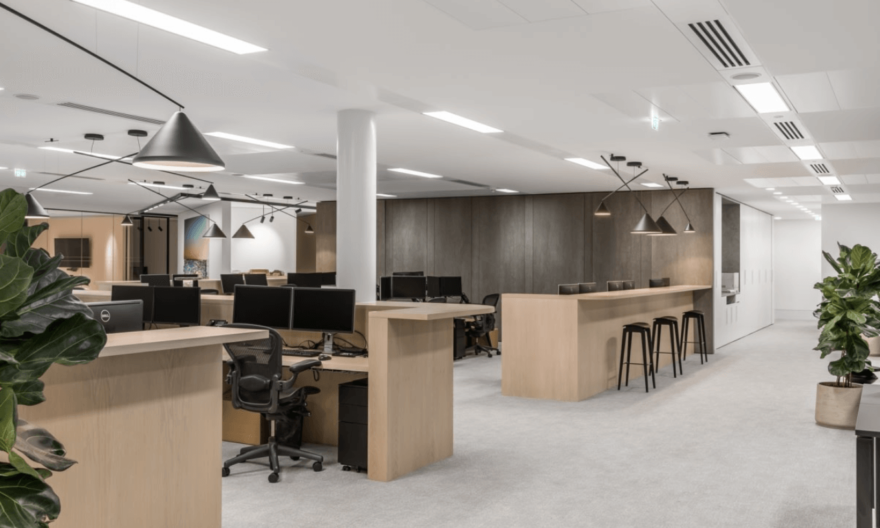
Ultimately, when designing your office space, you want to achieve two things: first, a useful and comfortable work atmosphere, and second, an efficient design that doesn’t waste any of the available space. That requires the insight of a professional office space designer!
We’ve put up a guide with all the essentials you need to take into account before beginning since we are aware of how crucial (and challenging) office space planning can be.
Continue reading for our best advice on organizing an office space effectively and efficiently:
Office Space Planning Guidelines: Things to Think About
Let’s now examine some particular office space planning recommendations.
#1. Per Employee Square Meters:
The average amount of space required by each person has significantly decreased over the past several years as a result of the popularity of open-plan workplaces and the growth of remote work. The average square footage allotted by companies per employee has dropped from 227 square feet at the turn of the century to 200 square feet now.
#2. Workplaces Each Employee Uses:
The amount of workplaces that are accessible to each employee is referred to as workspaces per employee. This ratio was often 1:1 in traditional workplaces, but as remote work and flexible work schedules have grown in popularity, 2:1 employee-to-desk ratios are becoming more typical.
The Ideal Rationale for Meeting Room Selection:

The average office worker participates in 62 meetings each month, thus having enough meeting spaces is essential. However, choosing the ideal conference room arrangement with your office renovation contractor is much more crucial. You should consider the following meeting room kinds while arranging your office space:
#1. Private One-on-One Rooms/Focus Rooms:
We deal with delicate or confidential meetings; these rooms give staff members a place to speak in private without being overheard. They are also suitable for employees who need to focus on a certain task and don’t want to be distracted by office chatter.
#2. Small Meeting Rooms and Huddle Spaces:
Huddle rooms are often smaller than regular meeting rooms and are perfect for brief, informal gatherings of 2–6 individuals as well as for brainstorming and problem-solving sessions.
#3. Large or Conventional Meeting Spaces:
Large meeting rooms are perfect for events requiring a lot of space, such as department-wide presentations, training sessions, client meetings, and so on.
#4. Meeting Room Dimensions:
There are a few things to consider when it comes to meeting room size, including the sort of meetings that will be conducted there, the typical number of attendees, and the quantity of technology that will be utilized. You may calculate the optimal square footage for each meeting space using that information.
Guidelines for Preserving Work-Life Balance While Working a Hybrid Schedule:
When you have a hybrid job, you’ll frequently have to juggle obligations at home and work. Here are some useful hints to assist you in striking a tidy balance:
#1. Set Apart a Particular Work Area for Yourself:
We are all aware of how distracting working from home can be. You’re trying to concentrate on a spreadsheet one moment, and then your eyes are caught by the mound of clothes that has to be folded. Setting up a designated workstation apart from the rest of your house is crucial because it helps you create mental and physical barriers between work and play and signals your brain that it’s time to work.
Lacking an office? No issue! Establish a workspace in your house, such as a desk or designated location. When you’re done working, you can “leave” the region and go to a relaxing state somewhere else.
#2. Create a Schedule and Follow It:
While working in a hybrid environment allows you the flexibility to work at your speed, it might occasionally cause you to work longer than necessary. In reality, 53% of employees are working longer hours today than they were in the office, and 38% of employees who work remotely experience burnout because they feel driven to put in more hours by management.
If so, it’s a good idea to create and follow a timetable. Decide on your working hours, including your start and end times as well as any scheduled breaks. By doing so, you’ll maintain your productivity while implementing restrictions that give you time to unwind from the office.
Making “wiggle room” for yourself is also useful; if something compels you to work after hours, that’s OK; just make sure you schedule “me time” to unwind and recharge.
#3. Promote Your Limitations:
The guilt that hybrid employees have for not being present at all times is one of the main obstacles they face, which is why 61% of remote workers now find it more challenging to “unplug” from work during non-working hours.
You need to be clear about your limits and establish expectations with your coworkers to resolve this. Make sure they are aware of your availability and absences so that nobody ever gets the impression that you are unresponsive or unavailable.
Read more: Ensure Your Guests Arrive in Comfort Using Chartered Buses for Weddings in Singapore




